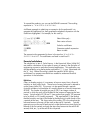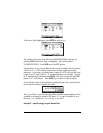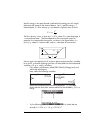
Page 6-11
payments. Suppose that we use 24 periods in the first line of the amortization
screen, i.e., 24 @@OK@@. Then, press @@AMOR@@. You will get the following
result:
This screen is interpreted as indicating that after 24 months of paying back the
debt, the borrower has paid up US $ 723,211.43 into the principal amount
borrowed, and US $ 215,963.68 of interest. The borrower still has to pay a
balance of US $1,276,788.57 in the next 36 months.
Check what happens if you replace 60 in the Payments: entry in the
amortization screen, then press @@OK@@ @@AMOR@@. The screen now looks like this:
This means that at the end of 60 months the US $ 2,000,000.00 principal
amount has been paid, together with US $ 347,937.79 of interest, with the
balance being that the lender owes the borrower US $ 0.000316. Of course,
the balance should be zero. The value shown in the screen above is simply
round-off error resulting from the numerical solution.
Press $or `, twice, to return to normal calculator display.
Example 3 – Calculating payment with payments at beginning of period
Let’s solve the same problem as in Examples 1 and 2, but using the option that
payment occurs at the beginning of the payment period. Use:
„Ò Start the financial calculation input form
60 @@OK@@ Enter n = 60
6.5 @@OK@@ Enter I%YR = 6.5 %
2000000 @@OK@@ Enter PV = 2,000,000 US$


















